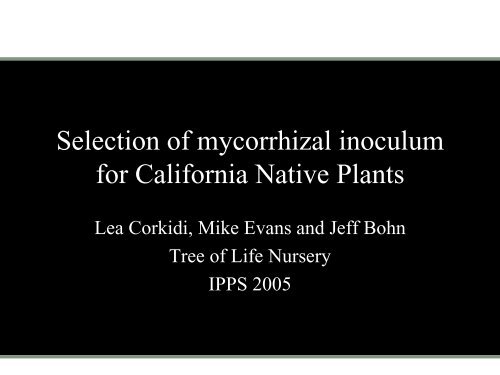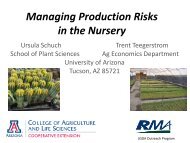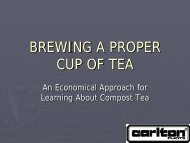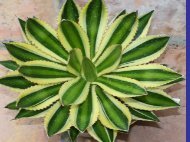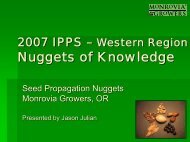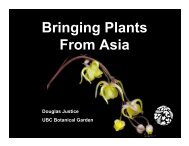Selection of mycorrhizal inoculum for California Native Plants
Selection of mycorrhizal inoculum for California Native Plants
Selection of mycorrhizal inoculum for California Native Plants
- No tags were found...
You also want an ePaper? Increase the reach of your titles
YUMPU automatically turns print PDFs into web optimized ePapers that Google loves.
<strong>Selection</strong> <strong>of</strong> <strong>mycorrhizal</strong> <strong>inoculum</strong> <strong>for</strong>Cali<strong>for</strong>nia <strong>Native</strong> <strong>Plants</strong>• Tree <strong>of</strong> Life Nursery?• What is a <strong>mycorrhizal</strong> fungi?• Why and how do we inoculate our plants with<strong>mycorrhizal</strong> fungi?• Why selection?
We GrowCali<strong>for</strong>nia native plantsTree <strong>of</strong> Life Nursery
Tree <strong>of</strong> Life Nursery• Most <strong>of</strong> the plants <strong>of</strong> theTree <strong>of</strong> Life nursery areinoculated with VAM 80.• VAM 80: Mycorrhizal<strong>inoculum</strong> propagated atthe nursery.
What is a <strong>mycorrhizal</strong> fungi?In the rhizosphere there are certain kind <strong>of</strong> fungi which arespecialized to colonize the roots <strong>of</strong> most plants and <strong>for</strong>mwith them a symbiotic organ called
Where do we find <strong>mycorrhizal</strong> fungi?• Under naturalconditions <strong>mycorrhizal</strong>fungi are ubiquitousThey are everywhere• We find them in the soilin the rhizosphere.
“The majority <strong>of</strong> plants strictly speaking do not haveroots, they have mycorrhizas”http://www.kent.ac.uk/bio/beg
What is a mycorrhiza?Mykes (greek) = fungusRhiza (latin) = rootBoth partners benefit from the association
Mycorrhizal fungi:A bridge between plants and soil resources• The fungi produce fine thread-like filaments that grow inand around the roots and develop an underground networkthat helps the plant to acquire mineral nutrients from thesoil.• The plant provides a “home” <strong>for</strong> the fungus and a supply<strong>of</strong> Carbon.Their association enables them to survive, grow and reproduce more effectivelyhttp://www.ffp.csiro.au/research/mycorrhiza
Mycorrhizal networksHyphae grow out into the soil, enlarging the absorbingcapacity <strong>of</strong> the root system, and acquire phosphate andother nutrients that <strong>of</strong>ten are too distant to be available tothe relatively coarse root system.Zhu, Y. et al. 2001. Backseat driving? Accessing phosphate beyond therhizosphere-depletion zone. Trends in Plant Science 6:194.
Value <strong>of</strong> <strong>mycorrhizal</strong> colonization in nurseryconditions• Increases plant growth• Increases planttolerance to water andsalt stress-VAM80+VAM80Dichelostemma capitatum0.04• Increases resistanceagainst pathogensBulb weight (g)0.030.020.01-AM+AM0
Types <strong>of</strong> <strong>mycorrhizal</strong> associationsEctomycorrhizasForest treesArbuscular mycorrhizasHerbaceous plants, shrubs, ornamentals,Fruit trees, vegetable crops, turf grassesEricoid mycorrhizasEricaceaeOrchidaceous mycorrhizasOrchids
Arbuscular <strong>mycorrhizal</strong> <strong>inoculum</strong>HyphaeColonized root fragmentsSpores
*Bever et al. 2001. Bioscience 51(11):923-929.Arbuscular <strong>mycorrhizal</strong> fungi: More diverse than meets the eye,and the ecological tale <strong>of</strong> why*• Spores are swollen structures• 160 species <strong>for</strong>m mycorrhizaswith 300,000 plants• AM fungi are not functionallyequivalent• Different geographic isolateshave different effects in plantgrowth and protection
ProductCommercial Mycorrhizal Inoculum1Glomus intraradices, G. mosseae, G. brasilianum, G. clarum,G. deserticola, G. monosporus and Gigaspora margarita2 Endo/Ecto <strong>mycorrhizal</strong> <strong>inoculum</strong>3 Glomus intraradices4 Glomus intraradices5 Glomus intraradices6 Glomus intraradices7 Glomus intraradices, Glomus aggregatum and Glomusmosseae8 Glomus intraradices9 Glomus intraradices, Glomus aggregatum and Glomusmosseae10 Glomus intraradicesGianinazzi, S., Vosatka, M. 2004. Inoculum <strong>of</strong> arbuscular <strong>mycorrhizal</strong> fungi <strong>for</strong> production systems: Science
Propagation <strong>of</strong> arbuscular <strong>mycorrhizal</strong> fungiAm fungi are obligate symbiontsPot culturesSoil and root tissue are collected from a site to start “trap cultures”and boost the number <strong>of</strong> propagules <strong>for</strong> isolation and further multiplication
Beyond the big plant - little plant• Benefits <strong>for</strong> plant growth and protection• Benefits in soil structure• Benefits <strong>for</strong> nursery• Benefits <strong>for</strong> environmentMultifunctional mycorrhizas
Top soil removalSoil compactionRestoration and revegetationDisturbed sites/constructionEliminates or severly reduces the <strong>mycorrhizal</strong><strong>inoculum</strong> potential <strong>of</strong> the soil
Arbuscular <strong>mycorrhizal</strong> fungi:The soil’s superglue• Fungal hyphae linksoil particles• AM fungi produce theglycoprotein glomalinMycorrhizal fungi influence soil structure
Mycorrhizal fungi: An environmentallyfriendly alternative• Valuable tool to minimize the use <strong>of</strong>fertilizers and pesticides
How do we incorporate <strong>mycorrhizal</strong> fungi at theTree <strong>of</strong> Life Nursery?1. AM fungi<strong>Plants</strong> in nurseries are grownin soilles mixes that do notcontain <strong>mycorrhizal</strong> fungi• Mycorrhizal associations arethree way interactionsbetween plants, growingmedium and soilPlantSoilFungi
PlantMycorrhizasCOST/BENEFITNutrient uptake - CarbonSoilSoilAM fungiAM fungiThe combination <strong>of</strong> these three factors will determine the successful application<strong>of</strong> mycorrhizas at the nursery
Mycorrhizal colonization is not always beneficialAre mycorrhizas always mutualisms?• The infectivity and effectiveness <strong>of</strong> aparticular AM fungi vary with the plant andgrowing medium• The choice and preparation <strong>of</strong> pottingmixes, fertilizers and pesticides is crucial.
Different products had different percentages <strong>of</strong><strong>mycorrhizal</strong> colonization in different mixesProduct 2504540Product 1aaaAM %50403020100aba35soilAM %302520151050Nursery mixSunshineAM %50403020Product 3baa100Corkidi, L. et al. 2004. Assessing the infectivity <strong>of</strong> commercial <strong>mycorrhizal</strong>Inoculants in plant nursery conditions. J. Env. Hort. 22(3):149-154.
<strong>Selection</strong> <strong>of</strong> compatible <strong>mycorrhizal</strong> fungus/hostandgrowing media combinations<strong>mycorrhizal</strong>non<strong>mycorrhizal</strong>Corkidi et al. 2005. Effectiveness <strong>of</strong> commercial <strong>mycorrhizal</strong> inoculants on the growth <strong>of</strong> Liquidambarstyraciflua. J. Env. Hort. 23(2):72-76.
Sources <strong>of</strong> <strong>mycorrhizal</strong> <strong>inoculum</strong>VAM 80Spores, hyphae androot fragments colonized by Glomus intraradices<strong>Native</strong> AM fungi
Highly infective species <strong>of</strong> woody and herbaceous plantsin a wide range <strong>of</strong> conditions.
Nursery versus environmental conditionsMycorrhizal fungi needed to sustain seedlings at the nurserymay differ from those that will help establishment in a harsh site
What’s the best approach <strong>for</strong> the selection <strong>of</strong><strong>mycorrhizal</strong> <strong>inoculum</strong>?• Effects <strong>of</strong> <strong>mycorrhizal</strong> colonization on the growth <strong>of</strong>Calochortus weedii var. intermedius
What’s the best approach <strong>for</strong> the selection <strong>of</strong> <strong>mycorrhizal</strong><strong>inoculum</strong>?Are native populations <strong>of</strong> AM fungi appropriate <strong>for</strong> thepropagation <strong>of</strong> intermediate • mariposa \ lily?orIs the inoculation <strong>of</strong> the more aggressive fungi present inmost commercial inoculants, Glomus intraradices,more effective to promote survival, growthand reproduction?
Effects <strong>of</strong> <strong>mycorrhizal</strong> colonization on the growth <strong>of</strong>Calochortus weedii var. intermedius• Bulbs <strong>of</strong> intermediatemariposa lily wereinoculated with• Top Soil• VAM 80• Sterile soil
Inoculum treatment Number <strong>of</strong> flowersNon<strong>mycorrhizal</strong> 7VAM 80 9Top Soil 18Bulbs inoculated with top soil had significantly more side branches and flowersthan those inoculated with VAM80, or than the non-<strong>mycorrhizal</strong> controls.
Successful application <strong>of</strong> mycorrhizas inhorticulture is a four way interaction
Ramiro (“Ramo”), Salvador, Sinfo, Toño,Chris Meloni, Jim Harrison,Becky Bohn and Daniel Evans


